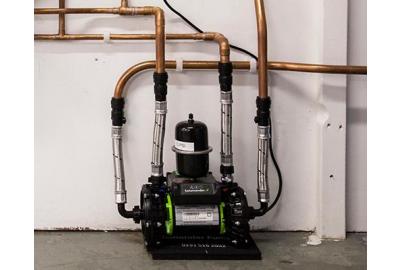Subsribe to our email newsletter today to receive product news and special offers!
If water flow from a shower is little more than a trickle, installing a Salamander shower pump or whole house pump to boost this flow is a clear solution when you have a gravity fed system. However, with such a wide variety of pumps available, selecting the right pump can be a job in itself. Here Salamander Pumps runs through everything that should be considered when selecting a pump.
1. Do i need a positive or negative head shower pump?
When it comes to gravity-fed systems, there are two available possibilities for shower pumps; positive head and universal pumps.
Positive head pumps are designed to work with only positive head gravity fed system, where there is 600mm from the bottom of the cold water storage to the highest point in the system AFTER the pump. Universal pumps, on the other hand, work with in both positive and negative head gravity fed systems. It is often used to supply water to an appliance where it is more difficult to rely on gravity alone. Most commonly this would occur when the water source is on the same level as the appliance, such as a loft conversion, or if pipes rise from an airing cupboard into the loft then down to a shower within 600mm of the tank base.
Universal shower pumps are also useful for providing a boost to appliances when required such as a dishwasher, washing machine or electric shower. This is because they tend to use a solenoid valve, which requires an initial pressure to start
2. Do i need a twin impeller or single shower pump?
An important factor to consider is if the shower pump is twin or single ended. The difference here is the number of impellers. Twin ended pumps can provide both hot and cold water to showers, bathrooms and whole house installations, whereas single impellers provide hot or cold water to single or multiple outlets.
Single pumps are ideal for suppling hot or cold water to individual taps, but are not suitable for providing water to appliances like mixer showers, unless raising gravity hot water pressure where the shower is supplied by mains, then a single negative head pump can be used
3. What shower pump bar rating is required?
A bar rating, simply put, is the measure of pressure, with one bar being equal to the pressure exerted by 10 meters of static head of water. The higher the bar rating the higher the pressure. A general guide would be 1.5 bar covering one appliance, 2 bar covering two or three appliances (or a whole bathroom) and 3 bar or above covering a whole houses worth of appliances.
Shower head size also needs to be factored in and needs to be in line with the bar rating. As a general rule of thumb, a 1-3inch sized shower head will be covered by a 1.5 bar pump; 3-5 inch is optimal with 2 bar and anything above 6 inches needs a bar rating of 3.
4. Shower or whole house?
While whole house pumps can be used for just showers, shower specific pumps are for thermostatic type shower valves only. A shower specific pump is designed to pump both hot and cold water at the same time. If connected to several outlets which may use just cold or just hot supplies, the shower specific pump will become damaged over a period of time as it does not have the facility to run ‘closed head’ on one side for long periods.
5. Noise levels of the shower pump
Finally, it’s important to take into account noise produced by the pump. Day to day noise will usually mask this, but at night the sound can seem more prominent due to the lack of background sound. The amount of disturbance depends on where in the house the pump will be fitted. If it was in an airing
cupboard right next to the bedroom, a quieter pump would be essential to avoid an unnecessary disturbance. The Salamander RP50PT Shower Pump is the quietest twin plastic shower pump in the UK at only 45.5dBA!
You can help improve the noise level by fitting an anti vibration shower pump mat
For further information pleasse visit www.salamanderpumps.co.uk






